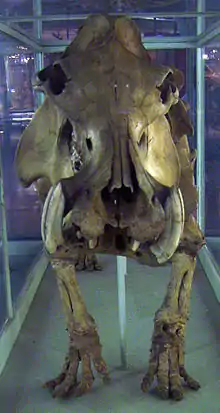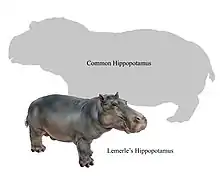Hippopotamus lemerlei
Hippopotamus lemerlei, or the Malagasy dwarf hippopotamus, is an extinct species of Malagasy hippopotamus.
| Hippopotamus lemerlei Temporal range: Holocene | |
|---|---|
 | |
| H. lehmerlei at the Museum für Naturkunde, Berlin | |
Extinct (1000) | |
| Scientific classification | |
| Kingdom: | Animalia |
| Phylum: | Chordata |
| Class: | Mammalia |
| Order: | Artiodactyla |
| Family: | Hippopotamidae |
| Genus: | Hippopotamus |
| Species: | †H. lemerlei |
| Binomial name | |
| †Hippopotamus lemerlei Stuenes, 1989 | |
Taxonomy
Malagasy hippopotamuses were first discovered in the mid-19th century by Alfred Grandidier, who unearthed nearly 50 individual hippos from a dried-up swamp at Ambolisaka near Lake Ihotry,[1][2] a few miles from the Mozambique Channel. In 1989, Scandinavian palaeontologist Solweig Stuenes described H. madagascariensis and H. lemerlei from these bones.[3][4]
It may have descended from full-sized hippos who shrunk due to insular dwarfism, similar to many Mediterranean island hippos, such as with the Cretan dwarf hippopotamus or the Cyprus dwarf hippopotamus.
Description
Hippopotamus lemerlei bones have been mostly discovered in the rivers and lakes (riparian environments) of western Madagascar, suggesting a habitat very similar to that of the modern hippo of modern Africa. H. lemerlei also shared the high-placed eyes that make it easier to see while submerged.[4]
Although a clear relative to the common hippopotamus, H. lemerlei was much smaller, roughly the size of the modern pygmy hippopotamus. The largest specimens were 2.0 m (6.5 ft) long and 2.5 ft (0.76 m) tall.
Bones of H. lemerlei have been dated to about 1,000 years ago (980±200 radiocarbon years before present.[5]
Paleoecology

Diet
Hippopotamus lemerlei and contemporary Aldabrachelys tortoises were the dominant grazers in Madagascar. Malagasy hippos in general, however, were less grass-specialised than the mainland African hippo.[6]
Extinction
Although there have been no remains dating to within the last thousand years, the hippopotamus has been surprisingly common in Malagasy oral legends. In different regions of Madagascar, stories were recorded of the mangarsahoc, the tsy-aomby-aomby, the omby-rano, and the laloumena, all animals that resembled hippopotamuses.[7] The strength of these oral traditions led the International Union for Conservation of Nature (IUCN) to classify H. lemerlei as recently extinct (going extinct some time after the year 1500).[8]
At least seven hippopotamus bones show unequivocal signs of butchery, suggesting that they survived until humans arrived on Madagascar, perhaps coexisting with humans for about 2,000 years. It is also possible that over-hunting by humans led to their extinction.[4]
References
- Stuenes, S. (1989). "Taxonomy, habits and relationships of the sub-fossil Madagascan hippopotamuses Hippopotamus lemerlei and H. madagascariensis". Journal of Vertebrate Paleontology. 9 (3): 241–268. doi:10.1080/02724634.1989.10011761.
- Nussbaum, Ronald A.; Raxworthy, Christopher J. (2000). The Ghost Geckos of Madagascar. New York: William Morrow. ISBN 978-0-380-97577-8.
- Stuenes, S. (1989). "Taxonomy, habits and relationships of the sub-fossil Madagascan hippopotamuses Hippopotamus lemerlei and H. madagascariensis". Journal of Vertebrate Paleontology. 9 (3): 241–268. doi:10.1080/02724634.1989.10011761.
- Tyson, P. (1998). The Eighth Continent; Life, Death and Discovery in the Lost World of Madagascar. Ann Arbor: Museum of Zoology, University of Michigan. ISBN 978-0380794652.
- Boisserie, J.-R. (2016). Hippopotamus lemerlei. The IUCN Red List of Threatened Species 2016. doi:10.2305/IUCN.UK.2016-1.RLTS.T40782A90128915.en
- Godfrey, L. R.; Crowley, B. E. (2016). "Madagascar's ephemeral palaeo-grazer guild: Who ate the ancient C4 grasses?". Proceedings of the Royal Society B: Biological Sciences. 283 (1834): 20160360. doi:10.1098/rspb.2016.0360. PMC 4947885. PMID 27383816.
- Burney, David A.; Ramilisonina (December 1998). "The Kilopilopitsofy, Kidoky, and Bokyboky: Accounts of Strange Animals from Belo-sur-mer, Madagascar, and the Megafaunal "Extinction Window"". American Anthropologist. 100 (4): 957–966. doi:10.1525/aa.1998.100.4.957. JSTOR 681820.
- Boisserie, J.-R. (2016). "Hippopotamus lemerlei". IUCN Red List of Threatened Species. 2016. doi:10.2305/IUCN.UK.2016-1.RLTS.T40783A90128828.en.CS1 maint: ref=harv (link)
| Wikimedia Commons has media related to Hippopotamus lemerlei. |